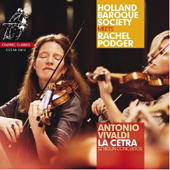
ESSENTIAL RECORDINGS

Violinist Rachel Podger began her recording career just about 20 years ago now, and along the way released many fine recordings in both solo and
ensemble roles, alongside leading figures like Trevor Pinnock, the Palladian Ensemble, Andrew Manze, etc ... One of the recordings that helped establish her reputation
was very much like this one. It was the best-selling recording, also on Channel Classics, of the Op. 4 Violin Concertos "La Stravaganza" by
Antonio Vivaldi. Released during the early days of Super Audio technology, it was hailed as one of the best sounding recordings to benefit from the SACD
recording technique, and also as one of the finest Vivaldi releases in many years. Although the backup band was different, the Arte Dei Suonatori back then as opposed
to the Holland Baroque Society on this new CD, both recordings compare very well.
It was Antonio Vivaldi (1680-1743) who encouraged the solo violin passages in the Concerto Grosso to become the dominant part of the complete
ensemble. He helped forge the concerto into a three-movement form (fast-slow-fast), which became the conventional arrangement used by Bach himself and the following
masters. His animated outer movements expose his imagination and sense of play (for example the opening of No. 1 in C major is a hoot), but I believe it's his slow
middle movements that reveal his fascination with music, and his mastery of color and sound. The Largo of No. 3 in G minor for example demonstrates
his willingness to explore new harmonic intervals as well as his ability to merge two distinct parts into one.
What I admire the most about this recording is the earnest approach that both Rachel Podger and the Holland Baroque Society
bring to this music. Unlike other so-called "historical performance" ensembles who either exaggerate or underplay the music strictly for effect or to seem innovative,
these musicians simply seek out the music's inner drama and bring it to the fore. Rachel Podger's 1739 Pesarinius violin seems tailor made for Vivaldi, and blends very
well with the ensemble's sonority. It certainly produces a sweeter sound than some of the proverbial "chalk on the blackboard" period instruments. All in all an enjoyable
and worthwhile addition to the large Vivaldi catalogue of recordings. A fresh new take on 'La Cetra' which should easily displace its other "outdated" recordings.
Jean-Yves Duperron - July 2012